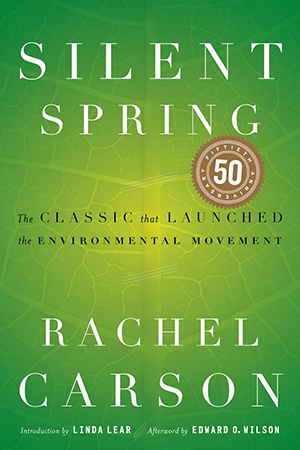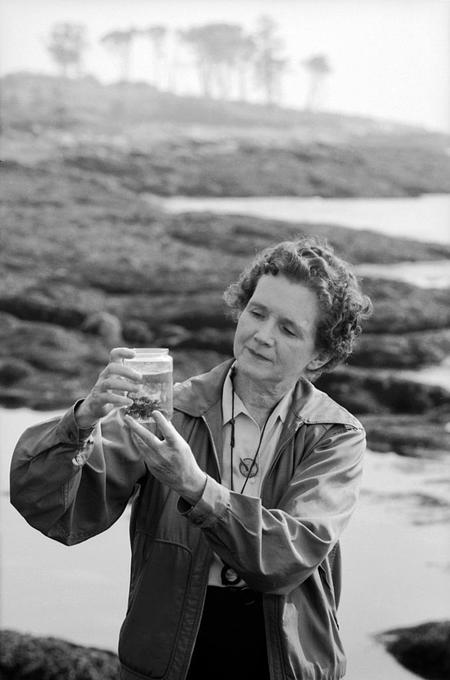An outstanding conservationist, marine biologist Rachel Carson was one of the finest nature writers of the 20th century; she is remembered today as the woman who challenged the notion that humans could obtain mastery over nature. Her sensational book Silent Spring, published in 1962, warned of the dangers to all natural systems from the misuse of chemical pesticides such as DDT, questioned the scope and direction of modern science, and initiated the contemporary environmental movement.
In her early life, she was educated at the University of Maryland, before joining the US Fish and Wildlife Service in 1936. This is when she started writing her first book, Under the Sea-Wind, published in 1941, in which she described marine life in clear, elegant, and non-technical prose. She retained her government job through the 1940s, until in 1951, she published The Sea Around Us, which became an immediate best-seller and freed her from financial worry.
During the 1950s, Rachel conducted research into the effects of pesticides on the food chain, published in her most influential work, Silent Spring, which condemned the indiscriminate use of pesticides. Unlike most pesticides, the effectiveness of which is limited to destroying one or two types of insects, DDT was capable of killing hundreds of different kinds at once. Developed in 1939, it first distinguished itself during World War II, clearing South Pacific islands of malaria-causing insects for US troops; while in Europe it was used as an effective de-lousing powder. Its inventor was awarded the Nobel Prize.
When DDT became available for civilian use in 1945, there were only a few people who expressed second thoughts about this new miracle compound. One was nature writer Edwin Way Teale, who warned that a spray as indiscriminate as DDT can upset the economy of nature as much as a revolution upsets social economy. Ninety percent of all insects are good, and if they are killed, the eco-system is immediately affected.
His warning influenced Rachel, who wrote to several newspapers and magazines to propose an article about a series of tests on DDT being conducted not far from where she lived in Maryland. They all repeatedly rejected the idea; this was when Silent Spring was given birth to.

Silent Spring took Carson four years to complete; it meticulously described how DDT entered the food chain and accumulated in the fatty tissues of animals, including human beings, causing cancer and genetic damage. A single application on a crop, she wrote, killed insects for weeks and months; not only the targeted insects, but countless more, and remained toxic in the environment even after it was diluted by rainwater.
Carson concluded that DDT and other pesticides had irrevocably contaminated the entire world food supply. The book’s most haunting and famous chapter, A Fable for Tomorrow, depicted a nameless American town where all life, from fish to birds to apple blossoms to human children, had been “silenced” by the insidious effects of DDT.
Once her book was published, it was heavily attacked by the chemicals industry which, not surprisingly, was making enormous profits selling DDT. One of the remarkable critic opinions highlighted that if Man were to faithfully follow the teachings of this book, we would return to the Dark Ages, and the insects and diseases and vermin would once again inherit the Earth.
Anticipating the reaction of the chemicals industry, Carson had compiled Silent Spring as one would a lawyer’s brief, with no fewer than 55 pages of notes and a list of experts who had read and approved the manuscript. Many eminent scientists rose to her defense, and when US President John F. Kennedy ordered the President’s Science Advisory Committee to examine the issues the book raised, its report thoroughly vindicated both Silent Spring and its author.
As a result, DDT came under much closer government supervision and was eventually banned. The public debate moved quickly from “whether pesticides were dangerous” to “which pesticides were dangerous”, and the burden of proof shifted from the opponents of unrestrained pesticide use to the chemicals’ manufacturers. It is certain, thus, that the most important legacy of Silent Spring was a new public awareness that nature was vulnerable to human intervention.

Conservation had never raised much broad public interest; the threats Carson outlined, however, were too frightening to ignore. As a result, and for the first time, the need to regulate chemicals industry in order to protect the environment became widely accepted. It is believed that was the point real environmentalism was born.
References
www.nrdc.org
www.biography.com
www.theguardian.com
This article was first published in print in SCIplanet, Spring 2016 issue.
Cover image source: practicandocultura.files.wordpress.com